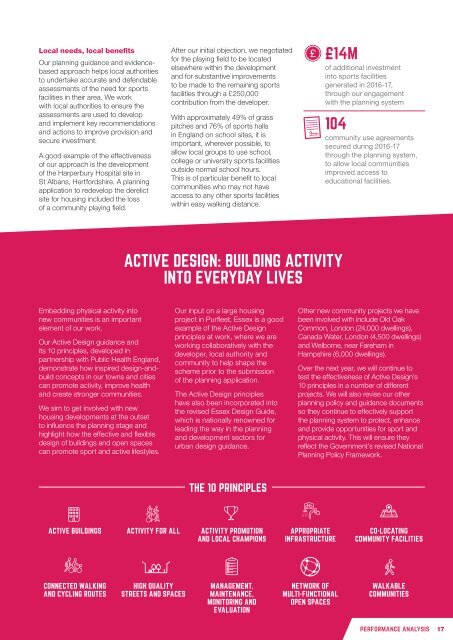SportEngland_AR_17_18
Create successful ePaper yourself
Turn your PDF publications into a flip-book with our unique Google optimized e-Paper software.
Local needs, local benefits<br />
Our planning guidance and evidencebased<br />
approach helps local authorities<br />
to undertake accurate and defendable<br />
assessments of the need for sports<br />
facilities in their area. We work<br />
with local authorities to ensure the<br />
assessments are used to develop<br />
and implement key recommendations<br />
and actions to improve provision and<br />
secure investment.<br />
A good example of the effectiveness<br />
of our approach is the development<br />
of the Harperbury Hospital site in<br />
St Albans, Hertfordshire. A planning<br />
application to redevelop the derelict<br />
site for housing included the loss<br />
of a community playing field.<br />
After our initial objection, we negotiated<br />
for the playing field to be located<br />
elsewhere within the development<br />
and for substantive improvements<br />
to be made to the remaining sports<br />
facilities through a £250,000<br />
contribution from the developer.<br />
With approximately 49% of grass<br />
pitches and 76% of sports halls<br />
in England on school sites, it is<br />
important, wherever possible, to<br />
allow local groups to use school,<br />
college or university sports facilities<br />
outside normal school hours.<br />
This is of particular benefit to local<br />
communities who may not have<br />
access to any other sports facilities<br />
within easy walking distance.<br />
£14M<br />
of additional investment<br />
into sports facilities<br />
generated in 2016-<strong>17</strong>,<br />
through our engagement<br />
with the planning system<br />
104<br />
community use agreements<br />
secured during 2016-<strong>17</strong><br />
through the planning system,<br />
to allow local communities<br />
improved access to<br />
educational facilities.<br />
ACTIVE DESIGN: BUILDING ACTIVITY<br />
INTO EVERYDAY LIVES<br />
Embedding physical activity into<br />
new communities is an important<br />
element of our work.<br />
Our Active Design guidance and<br />
its 10 principles, developed in<br />
partnership with Public Health England,<br />
demonstrate how inspired design-andbuild<br />
concepts in our towns and cities<br />
can promote activity, improve health<br />
and create stronger communities.<br />
We aim to get involved with new<br />
housing developments at the outset<br />
to influence the planning stage and<br />
highlight how the effective and flexible<br />
design of buildings and open spaces<br />
can promote sport and active lifestyles.<br />
Our input on a large housing<br />
project in Purfleet, Essex is a good<br />
example of the Active Design<br />
principles at work, where we are<br />
working collaboratively with the<br />
developer, local authority and<br />
community to help shape the<br />
scheme prior to the submission<br />
of the planning application.<br />
The Active Design principles<br />
have also been incorporated into<br />
the revised Essex Design Guide,<br />
which is nationally renowned for<br />
leading the way in the planning<br />
and development sectors for<br />
urban design guidance.<br />
Other new community projects we have<br />
been involved with include Old Oak<br />
Common, London (24,000 dwellings),<br />
Canada Water, London (4,500 dwellings)<br />
and Welborne, near Fareham in<br />
Hampshire (6,000 dwellings).<br />
Over the next year, we will continue to<br />
test the effectiveness of Active Design’s<br />
10 principles in a number of different<br />
projects. We will also revise our other<br />
planning policy and guidance documents<br />
so they continue to effectively support<br />
the planning system to protect, enhance<br />
and provide opportunities for sport and<br />
physical activity. This will ensure they<br />
reflect the Government’s revised National<br />
Planning Policy Framework.<br />
THE 10 PRINCIPLES<br />
ACTIVE BUILDINGS ACTIVITY FOR ALL ACTIVITY PROMOTION<br />
AND LOCAL CHAMPIONS<br />
APPROPRIATE<br />
INFRASTRUCTURE<br />
CO-LOCATING<br />
COMMUNITY FACILITIES<br />
CONNECTED WALKING<br />
AND CYCLING ROUTES<br />
HIGH QUALITY<br />
STREETS AND SPACES<br />
MANAGEMENT,<br />
MAINTENANCE,<br />
MONITORING AND<br />
EVALUATION<br />
NETWORK OF<br />
MULTI-FUNCTIONAL<br />
OPEN SPACES<br />
WALKABLE<br />
COMMUNITIES<br />
performance analysis report <strong>17</strong>








